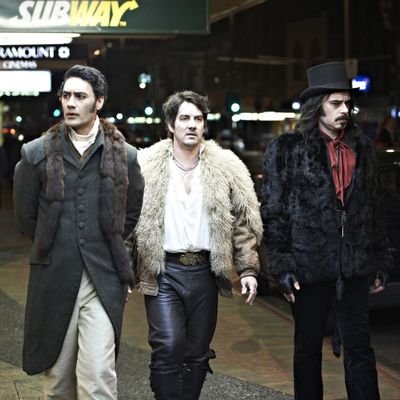
Parody is often regarded as the shallowest form of comedy, but when it’s powered by sympathy and emotional truth, it can transcend — even supplant — its target and become something positively moving. That’s why This is Spinal Tap — with its honest love of the fantasy of being a rock star, even a failing one — seems more “real” than real rock docs, and why the characters in the best of Christopher Guest’s mockumentaries are not just fools but holy fools, radiant in their humanity. It’s why some of us want to scream with pleasure when Jemaine Clement in Flight of the Conchords delivers a number like “Business Time,” which reproduces the groovy-sexy cool of the most seductive song-stylists while capturing the essence of an oblivious, over-entitled child-man. Great parody doesn’t wink; it deconstructs.
Though these vampires are hundreds, in one case thousands of years old, they seem as comfortable as our “Say Anything” generation revealing their innermost feelings to millions of strangers. In a beard and top hat that make him resemble the Portuguese antihero Coffin Joe, Vlad explains that back when he tortured and murdered thousands of people, he was “in a bad place.” He’s more reflective after an emasculating encounter with something called “the Beast” — which turns up later and is, indeed, horrifying. A relatively young (under two centuries) bloodsucker, Deacon (Jonathan Brugh), regards himself as catnip for the ladies and strings along a human “slave,” Jackie (Jackie van Beek) by promising her eternal life. Someday. She’s beginning to think he’s exploiting her.
Their lives — like those of many college boys — revolve around vegging out, partying (to find victims), and slaking the munchies (releasing gouts of blood). Occasionally they pass a rival frat of lycanthropes led by Conchord’s “Murray,” Rhys-Darby, who’s mature enough to get between hissing vampires and snarling werewolves and stop his pals from transforming. (“We talked about this… Just breathe… Breathe…”) Before the joke pales, a narrative of sorts kicks in. A victim (Cori Gonzalez-Macuer) survives and becomes a vampire himself but is loath to part with his human mate, Stu (Stuart Rutherford)—a mild fellow for whom the others, unused to sharing their place with someone not undead, develop a competitive and faintly homoerotic affection. But how can they keep other ghouls from eating him?
I can think of many reasons why What We Do in the Shadows kills. Inserts of demon-depicting paintings and wood cuttings that span centuries and cultures are beautifully evocative—even with our vampire protagonists’ heads photoshopped in. Clement and Waititi are intimate with the conventions of vampire movies and reality TV and must have had a crazy-great time blending the unblendable in the best SCTV tradition. But it’s the absence of camp that I keep coming back to. They scale it down and play it real. They’re undeadpan.
*This article appears in the February 9, 2015 issue of New York Magazine.





